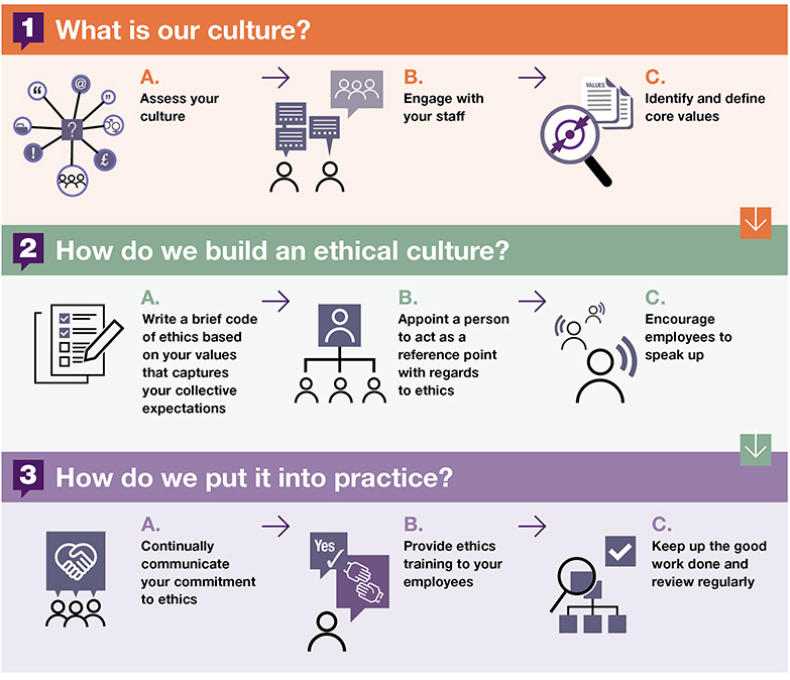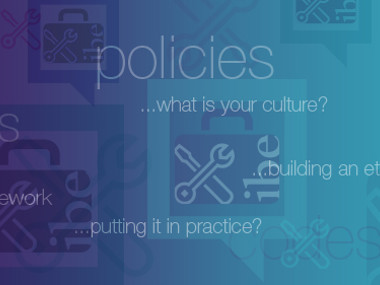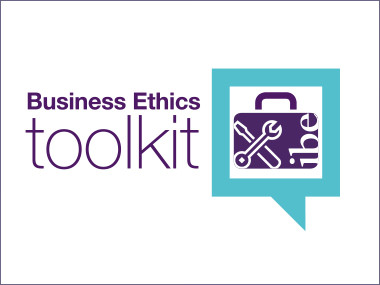Build the framework
The process that follows suggests a simple way to build a business ethics framework, guiding you step by step in the definition of the framework most suitable for your business without requiring significant resources and bureaucracy. It is important to remember that there is no ‘one-size-fits-all’ approach and for the approach to ethics to be effective, it has to be tailored to the specific needs of your organisation.
The IBE Three-step process to build an ethics framework
This easy-to-use process will help you get started and engage with your employees on ethics matters. It will guide you through all the stages of the development and implementation of a practical framework that truly reflects your organisation’s values.

STEP 1: What is our culture?
All organisations have a culture, which is the product of different factors, including the shared values (explicit and implicit) and accepted behaviours. A simple way of putting it is that the culture of an organisation is "how we do things around here". But how can you assess whether the culture in your organisation is ethical? To get started, reflect on the way you do your business: what values are important to you and how would you describe the culture of your organisation?
You can discuss this with your employees and key stakeholders. An open discussion about the organisation’s culture ensures that the formalisation to the commitment to doing the right thing is meaningful to those in your organisation and has buy-in support from your staff, as well as enabling everyone to feel responsible for promoting high ethical standards.
A. Assess your culture
You can start by assessing how your organisation does business. Identify the strengths and weaknesses in your existing ethical culture; agree what attitudes and skills need to be encouraged or built.
This step provides an important opportunity to spot potential gaps and to determine the changes that need to be introduced to ensure your ethical standards are maintained. It is also an opportunity to engage with some of your stakeholders that you think can help you to gain a better understanding of some of the aspects of your organisation’s culture, as you find appropriate.
The culture of an organisation can be difficult to define on paper. Answering some of the following questions might be a useful guide to approach this task:
- What is the purpose of my organisation?
- Does my organisation have a formalised vision or mission statement? If so, what is it?
- What geographical areas or regions does my organisation cover? What are the stakeholder groups that are most relevant to us?
- What are the main strengths of my firm and what is it that makes my organisation different from the competitors?
- What are the main weaknesses of my organisation?
- What are the main challenges or ethical risks that my organisation has to face? What steps have we taken to tackle them?
- Have we ever had to face an ethical crisis? How did we respond?
- What is the most frequent complaint that our employees, customers and suppliers make?
B. Engage with your staff
Gather together a group of people from within your firm – it might be composed of all employees if the organisation is small enough or it might be a selected ‘Steering Group’ representing the different functions and levels. Either way, it is important that all employees feel represented and different views are brought together, empowering everyone to take personal responsibility.
Explain to them the importance of doing the right thing, of formalising your ethical values and how relevant their input can be. Then seek their advice: schedule a meeting to gather their opinions and ask them to write some notes in simple words about their thoughts summing up ‘what it is like to work here’. Encourage them to discuss the most important issues the business faces and the changes they would like to make to address these.
If you can’t involve all your staff personally, you might want to consider surveying their opinion through simple questionnaires, either on paper or online, on some key aspects (e.g. what are the most serious ethical dilemmas that we face? Here you can find some examples of ethical dilemmas that might help the discussion). A broad engagement process is crucial to give strength and internal support to the initiative, as this is the first stage of embedding.
C. Identify and define core values
Once you have a clearer picture of your culture and have engaged with your staff, you can then ask your employees to help you identify what the organisation’s core values should be. Organisation's core values are normally a mix between ethical values (such as respect, fairness and honesty) and business values (such as innovation, customer service, excellence).
Values can be thought of as a compass to guide employees in how they work setting agreed standards of behaviour, expressing beliefs about the ‘good’ and the ‘right’ in the context of the organisation. So it makes sense that employees are involved in the process and recognise them in the way business is done on a daily basis.
STEP 2: How do we build an ethical culture?
Building on the understanding developed during the first step, you can now outline an ethics framework that closely reflects the purpose, goals and values of your organisation.
‘Ethics begins where the law ends’, as it goes beyond legal compliance. However, compliance with the law is an essential first step. It is important to know and comply with the laws and regulations that apply, with particular attention to some key areas. However, legal compliance on its own is not sufficient to create an ethical culture in your organisation.
A. Write a brief code of ethics based on your values that captures your collective expectations
If ethical values are the compass which guides how you do business, then a Code of Ethics is like a map. It sets out the expectations that the organisation has for how employees should behave in any given situation, to assist with decision-making. So for example, if an employee is offered an expensive gift in return for signing a contract, they will be able to refer to the Code of Ethics to see whether or not that would be in line with how the organisation wishes to behave. It brings the organisation’s core values to life by translating them into specific commitments and expected behaviour in relation to the organisation’s key stakeholder groups.
Appoint a person to be responsible for drafting this document. It should reflect the employees’ input and views. Make sure that this draft is then reviewed and approved by a representative group of your staff before it is finalised and signed off by top management and/or the board.
B. Appoint a person to act as a reference point with regards to ethics
It may be helpful to identify an Ethics Champion - a designated person within the organisation to take responsibility for overseeing how ethics is applied. Often this is a part-time role by someone with knowledge and experience of the company. That person can also serve as a point of reference for the other employees on ethics matters, reminding them that the responsibility for the promotion of ethics lies with each individual employee. The important thing is that they have a managerial role and that your employees recognise them as somebody who lives up your organisation’s values and trust them to do the right thing even in difficult situations.
Depending on the size and the needs of your organisation, you can appoint other people to help the Ethics Champion throughout the business.
The Ethics Champion is an employee selected to assist senior management in promoting and embedding the ethics policies, codes of conduct, business principles, statements of values or other similar policies of their organisations in the place where they work.
The post of Ethics Champion is often taken on in addition to an employee’s day-to-day job. They contribute to the embedding of ethical values and strengthen the ethics programme by:
- Reminding and cajoling leaders into discharging their responsibilities, so that ethics programmes remain ‘top of mind’
- Developing relevant case studies to be used for training purposes
- Enhancing employee knowledge, acceptance and implementation of the ethics policy
- Offering on-the-ground support to employees
- Advocating the importance of ethics in decision making.
- Possibly act as the first port of call for employees who want to raise a concern about ethics (as discussed in the next paragraph about Speak Up).
C. Encourage your employees to speak up
An open culture, where employees are encouraged to ask questions or to express concerns about what the business is doing, is crucial to promote ethical standards. Enabling people to speak up in an open and transparent manner is part of good business management for a number of reasons, not least because it is a proven way of detecting problems when they are still at the early stage. However, it can be difficult to achieve, as it can be hard to hear criticism or complaints from employees.
It is important that there is some straightforward way for employees to express their concerns without fear of retaliation. This can be difficult in a small team, but there are options you can try to achieve this goal. The most common way to do this is directly with the person's line manager. If this is inappropriate, it should be possible to resort to other ways. You could provide an email address, encourage employees to refer to the ethics ambassador or place a confidential box in the office. Identifying an independent member of the board (if applicable) as the ultimate port of call for employees to raise their concerns might be helpful. It is important to bear in mind that, in order to be effective, these initiatives need to be provided in a context aimed at creating an atmosphere of trust, where concerns are taken seriously and confidentiality is respected.
If you want to seek external support, the whistleblowing charity Protect can assist you. Its aim is to encourage speaking up in the workplace by supporting individuals seeking advice on how to raise their concerns and by assisting organisations with their Speak Up programmes. In addition, you can direct your staff to the IBE’s free-to-use Speak Up Toolkit.
STEP 3: How do we put it into practice?
Once your ethics framework is in place, it is important to ensure that it finds long-term application in practice. This needn’t be complicated or bureaucratic to guarantee its effectiveness. However, there are some steps that can be considered.
A. Continually communicate your commitment to ethics
Make sure all employees know about your ethics framework and the behaviours that are in line with your ethical values. It is advisable that you ensure each receives, reads and has the chance to discuss the ethics code, and most importantly that they buy into its spirit. This starts at recruitment, by discussing your ethical values and culture, and at induction with new employees. It is also advisable to introduce regular short sessions where staff can discuss different ethical issues, for example during team meetings – best done by a dilemma discussion (here you can find some examples of ethical dilemmas for discussion), or “bring a headline to work” discussion, encouraging your colleagues to share a newspaper headline which presents a particularly relevant ethical dilemma.
Make sure that ethics is part of the conversations both internally and with external stakeholders; encourage your employees to discuss issues of right and wrong when they face them, so it becomes a natural topic to raise.
B. Provide ethics training to your employees
The majority of people you meet and deal with will already have good personal ethics, so you are not training your team members to be ‘ethical people’ but helping them to be aware of ethical issues. You want them to understand what it means to live up to your corporate values at work, particularly when they are working under pressure to deliver. This is something that can be taught.
IBE research shows that providing this type of training can have lasting positive effects on an ethical organisational culture, such as employees speaking up about unethical behaviour and a general perception of honesty in the workplace.
There are organisations that offer e-learning packages focused on ethics that you can use. Alternatively, an effective way of providing ethics training to your team members is by encouraging them to discuss some relevant ethical dilemmas, perhaps at the beginning of team meetings.
C. Keep up the good work done and review regularly
In order for your ethics framework to be effective, it is important that you keep it up-to-date and relevant to your employees. You can do this by:
- Reviewing the code (or ethics statement) regularly. Revisit the code or the ethics statement regularly to include new issues that your organisation might face and to adapt it to your employees’ needs.
- Recruiting the ‘right’ people. Always conduct appropriate ethical due diligence as part of the recruiting process. Assess candidates in terms of their fit with the ethical culture and values of the organisation to make sure you have a shared understanding of the types of behaviours that are expected and acceptable.
- Working with the ‘right’ people. Do ethical due diligence on your business partners, customers and suppliers. Do they share your values?
- Rewarding those who do the right thing. Even if this is just a verbal congratulation in a group meeting, this will send a strong message about the kind of behaviour that is encouraged and approved. It might be helpful to make this information publicly available (blog, social media, intranet, team meetings, in larger organisations you can use newsletters...). At the same time, it is important that those who achieve high performance through improper conduct are penalised.
- Leading by example. The quality and style of leadership in a business will influence the tone of the entire business. Usually in SMEs the owner-manager has a strong influence on the organisation’s culture and is able to undertake cultural changes when necessary in a shorter period of time compared to bigger companies.
- Providing assurance that the framework is working. One of the key drivers for companies to take a formalised approach to their ethical commitment is to demonstrate to their stakeholders that they are trustworthy. Collecting and communicating information about your ethics framework and the various processes in place is important to provide assurance to the board and to other stakeholders that the systems in place are working effectively.



